Comparative Study of the Structural, Microstructural, and Mechanical Properties of Geopolymer Pastes Obtained from Ready-to-Use Metakaolin–Quicklime Powders and Classic Geopolymers
Abstract
:1. Introduction
2. Materials and Methods
2.1. Materials
2.2. Methods
3. Results and Discussions
3.1. Ready to Use Powders
3.2. Comparative Study of the Properties of Geopolymer Pastes Produced from RUPG and Classic Geopolymers
4. Conclusions
- Structural and microstructural insights: X-ray diffraction (XRD) analysis reveals that traditional methods produce slight amorphization in MK, resulting in N(K)-A-S-H gels. Conversely, RUPG incorporates additional calcium silicate hydrate (C-S-H/C-A-S-H) phases, suggesting a potentially more robust microstructure that could contribute to enhanced mechanical properties and durability.
- Mechanical properties: Both GP and classic geopolymer pastes (CGPs) achieved notable compressive strengths of 31.45 MPa and 34.92 MPa, respectively, after 28 days of curing. The slightly superior compressive strength of CGP underscores the potential advantages of traditional methods in applications where high strength is crucial.
Author Contributions
Funding
Institutional Review Board Statement
Informed Consent Statement
Data Availability Statement
Conflicts of Interest
References
- Davidovits, J. Geopolymers—Inorganic Polymeric New Materials. J. Therm. Anal. 1991, 37, 1633–1656. [Google Scholar] [CrossRef]
- Singh, N.B.; Middendorf, B. Geopolymers as an Alternative to Portland Cement: An Overview. Constr. Build. Mater. 2020, 237, 117455. [Google Scholar] [CrossRef]
- Davidovits, J. Properties of Geopolymer Cements. In Proceedings of the First International Conference on Alkaline Cements and Concretes, Kiev, Ukraine, 11–14 October 1994; pp. 131–149. [Google Scholar]
- Meesala, C.R.; Verma, N.K.; Kumar, S. Critical Review on Fly-Ash Based Geopolymer Concrete. Struct. Concr. 2020, 21, 1013–1028. [Google Scholar] [CrossRef]
- Temuujin, J.; Rickard, W.; Lee, M.; Van Riessen, A. Preparation and Thermal Properties of Fire Resistant Metakaolin-Based Geopolymer-Type Coatings. J. Non-Cryst. Solids 2011, 357, 1399–1404. [Google Scholar] [CrossRef]
- Zerzouri, M.; Bouchenafa, O.; Hamzaoui, R.; Ziyani, L.; Alehyen, S. Physico-Chemical and Mechanical Properties of Fly Ash Based-Geopolymer Pastes Produced from Pre-Geopolymer Powders Obtained by Mechanosynthesis. Constr. Build. Mater. 2021, 288, 123135. [Google Scholar] [CrossRef]
- Zerzouri, M.; Hamzaoui, R.; Ziyani, L.; Alehyen, S. Influence of Slag Based Pre-Geopolymer Powders Obtained by Mechanosynthesis on Structure, Microstructure and Mechanical Performance of Geopolymer Pastes. Constr. Build. Mater. 2022, 361, 129637. [Google Scholar] [CrossRef]
- Luukkonen, T.; Abdollahnejad, Z.; Yliniemi, J.; Kinnunen, P.; Illikainen, M. One-Part Alkali-Activated Materials: A Review. Cem. Concr. Res. 2018, 103, 21–34. [Google Scholar] [CrossRef]
- Fitzgerald, M.; James, L. United States Patent (19). 1987. Available online: https://patentimages.storage.googleapis.com/eb/9e/dc/50e6b2c00604f0/US4767095.pdf (accessed on 13 August 2024).
- Koloušek, D.; Brus, J.; Urbanova, M.; Andertova, J.; Hulinsky, V.; Vorel, J. Preparation, Structure and Hydrothermal Stability of Alternative (Sodium Silicate-Free) Geopolymers. J. Mater. Sci. 2007, 42, 9267–9275. [Google Scholar] [CrossRef]
- Nematollahi, B.; Sanjayan, J.; Shaikh, F.U.A. Synthesis of heat and ambient cured one-part geopolymer mixes with different grades of sodium silicate. Ceram. Int. 2015, 41, 5696–5704. [Google Scholar] [CrossRef]
- Nematollahi, B.; Sanjayan, J.; Qiu, J.; Yang, E. Micromechanics-Based Investigation of a Sustainable Ambient Temperature Cured One-Part Strain Hardening Geopolymer Composite. Constr. Build. Mater. 2017, 131, 552–563. [Google Scholar] [CrossRef]
- Suryanarayana, C. Mechanical Alloying and Milling; Marcel Dekker: New York, NY, USA, 2004; ISBN 9780824741037. [Google Scholar]
- Suryanarayana, C. Mechanical Alloying and Milling. Prog. Mater. Sci. 2001, 46, 1–184. [Google Scholar] [CrossRef]
- Kumar, S.; Kumar, R. Mechanical Activation of Fly Ash: Effect on Reaction, Structure and Properties of Resulting Geopolymer. Ceram. Int. 2011, 37, 533–541. [Google Scholar] [CrossRef]
- Mucsi, G.; Kumar, S.; Csoke, B.; Kumar, R.; Molnár, Z.; Rácz, Á.; Mádai, F.; Debreczeni, Á. Control of Geopolymer Properties by Grinding of Land Filled Fly Ash. Int. J. Miner. Process. 2015, 143, 50–58. [Google Scholar] [CrossRef]
- Xia, M.; Sanjayan, J. Method of Formulating Geopolymer for 3D Printing for Construction Applications. JMADE 2016, 110, 382–390. [Google Scholar] [CrossRef]
- Garcia-diaz, E.; Réactivité, E.G.; Garcia-diaz, E.; Kaolinites, M.D.E.S. Réactivité Pouzzolanique Des Métakaolinites: Corrélations Avec Les Caractéristiques Minéralo-Gitologiques Des Kaolinites. 2013. Available online: https://theses.hal.science/tel-00843099v1/document.
- Wan, Q.; Rao, F.; Song, S. Reexamining Calcination of Kaolinite for the Synthesis of Metakaolin Geopolymers—Roles of Dehydroxylation and Recrystallization. J. Non-Cryst. Solids 2017, 460, 74–80. [Google Scholar] [CrossRef]
- Gharzouni, A. Contrôle de l’attaque Des Sources Aluminosilicates Par La Compréhension Des Solutions Alcalines. Ph.D. Thesis, Université de Limoges, Limoges, France, 2016. [Google Scholar]
- Pouhet, R.; Cyr, M. Formulation and Performance of Flash Metakaolin Geopolymer Concretes. Constr. Build. Mater. 2016, 120, 150–160. [Google Scholar] [CrossRef]
- San Nicolas, R.; Cyr, M.; Escadeillas, G. Characteristics and Applications of Flash Metakaolins. Appl. Clay Sci. 2013, 83–84, 253–262. [Google Scholar] [CrossRef]
- Almusallam, T. Effect of Sodium Silicate to Sodium Hydroxide Ratios on Strength and Microstructure of Fly Ash Geopolymer Binder. Chem. Eng. 2014, 39, 4333–4339. [Google Scholar] [CrossRef]
- Phoo-ngernkham, T.; Maegawa, A.; Mishima, N.; Hatanaka, S.; Chindaprasirt, P. Effects of Sodium Hydroxide and Sodium Silicate Solutions on Compressive and Shear Bond Strengths of FA—GBFS Geopolymer. Constr. Build. Mater. 2015, 91, 1–8. [Google Scholar] [CrossRef]
- Matalkah, F.; Aqel, R.; Ababneh, A. ScienceDirect ScienceDirect ScienceDirect Enhancement of the Mechanical Properties of Kaolin Geopolymer Enhancement of Sodium the Mechanical Properties of Kaolin Geopolymer Using Hydroxide and Calcium Oxide Using Sodium Hydroxide and Calcium Oxide. Procedia Manuf. 2020, 44, 164–171. [Google Scholar] [CrossRef]
- Matalkah, F.; Xu, L.; Wu, W.; Soroushian, P. Mechanochemical Synthesis of One-Part Alkali Aluminosilicate Hydraulic Cement. Mater. Struct./Mater. Et Constr. 2017, 50, 1–20. [Google Scholar] [CrossRef]
- Bouchenafa, O.; Hamzaoui, R.; Bennabi, A.; Colin, J. PCA Effect on Structure of Fly Ashes and Slag Obtained by Mechanosynthesis. Applications: Mechanical Performance of Substituted Paste CEMI + 50% Slag/or Fly Ashes. Constr. Build. Mater. 2019, 203, 120–133. [Google Scholar] [CrossRef]
- Kopp Alves, A.; Bergmann, C.P.; Berutti, F.A. High-Energy Milling. In Novel Synthesis and Characterization of Nanostructured Materials; Springer: Berlin/Heidelberg, Germany, 2013; pp. 77–85. ISBN 978-3-642-41274-5. [Google Scholar]
- Bouchenafa, O.; Hamzaoui, R.; Azem, L.; Bennabi, A.; Colin, J. Manufacturing Equivalent Clinker by Indirect Mechanosynthesis Process. In Proceedings of the 1st International Conference on Innovations in Low-Carbon Cement & Concrete Technology, London, UK, 24–26 June 2019; pp. 1–4. [Google Scholar]
- Rossana, B.; Carlo, C.; Paola, M.; Giovanna, Z. Rocks with asbestos: Risk evaluation by means of an abrasion test. Am. J. Environ. Sci. 2009, 5, 501. [Google Scholar] [CrossRef]
- Hamzaoui, R.; Bouchenafa, O.; Ben Maaouia, O.; Guessasma, S. Introduction of Milled Kaolinite Obtained by Mechanosynthesis to Cement Mixture for the Production of Mortar: Study of Mechanical Performance of Modified Mortar. Powder Technol. 2019, 355, 340–348. [Google Scholar] [CrossRef]
- Yaseri, S.; Hajiaghaei, G.; Mohammadi, F.; Mahdikhani, M.; Farokhzad, R. The Role of Synthesis Parameters on the Workability, Setting and Strength Properties of Binary Binder Based Geopolymer Paste. Constr. Build. Mater. 2017, 157, 534–545. [Google Scholar] [CrossRef]
- Rożek, P.; Król, M.; Mozgawa, W. Spectroscopic Studies of Fly Ash-Based Geopolymers. Spectrochim. Acta—Part A Mol. Biomol. Spectrosc. 2018, 198, 283–289. [Google Scholar] [CrossRef] [PubMed]
- Wu, F.; Li, H. Effects Of High Salinity Wastewater On The Properties Of Coal Gasification Residue-Based Cementitious Material. Therm. Sci. 2021, 26, 4161–4169. [Google Scholar] [CrossRef]
- Rees, C.A.; Provis, J.L.; Lukey, G.C.; Van Deventer, J.S.J. In Situ ATR-FTIR Study of the Early Stages of Fly Ash Geopolymer Gel Formation. Langmuir 2007, 23, 9076–9082. [Google Scholar] [CrossRef] [PubMed]
- Allali, F.; Joussein, E.; Kandri, N.I.; Rossignol, S. The Influence of Calcium Content on the Performance of Metakaolin-Based Geomaterials Applied in Mortars Restoration. Mater. Des. 2016, 103, 1–9. [Google Scholar] [CrossRef]
- Loy, C.W.; Matori, K.A.; Lim, W.F.; Schmid, S.; Zainuddin, N.; Wahab, Z.A.; Alassan, Z.N.; Zaid, M.H.M. Effects of Calcination on the Crystallography and Nonbiogenic Aragonite Formation of Ark Clam Shell under Ambient Condition. Adv. Mater. Sci. Eng. 2016, 2016, 2914368. [Google Scholar] [CrossRef]
- Yousuf, M.; Mollah, A.; Hess, T.R.; Tsai, Y.N.; Cocke, D.L. An FTIR and XPS Investigations of the Effects of Carbonation on the Solidification/Stabilization of Cement Based Systems-Portland Type V with Zinc. Cem. Concr. Res. 1993, 23, 773–784. [Google Scholar] [CrossRef]
- Alehyen, S.; El Achouri, M.; Taibi, M. Characterization, Microstructure and Properties of Fly Ash-Based Geopolymer. J. Mater. Environ. Sci. 2017, 8, 1783–1796. [Google Scholar]
- Davidovits, J. Geopolymer Chemistry and Applications, 5th ed.; Geopolymer Institute: Saint-Quentin, France, 2020; ISBN 9782954453118. [Google Scholar]
- Mobili, A.; Tittarelli, F. Applied Sciences One-Part Alkali-Activated Pastes and Mortars Prepared with Metakaolin and Biomass Ash. Appl. Sci. 2020, 10, 5610. [Google Scholar] [CrossRef]
- Gharzouni, A.; Joussein, E.; Samet, B.; Baklouti, S.; Rossignol, S. Effect of the Reactivity of Alkaline Solution and Metakaolin on Geopolymer Formation. J. Non-Cryst. Solids 2015, 410, 127–134. [Google Scholar] [CrossRef]
- Kassem, N.N.; Kishar, E.A.; Ahmed, D.A. Effect of Elevated Temperatures on The Performance of Metakaolin Geopolymer Pastes Incorporated by Cement Kiln Dust. Egypt. J. Chem. 2021, 64, 1911–1926. [Google Scholar] [CrossRef]
- Tantawy, M.A. Effect of High Temperatures on the Microstructure of Cement Paste. J. Mater. Sci. Chem. Eng. 2017, 5, 33–48. [Google Scholar] [CrossRef]
- Nikolov, A.; Rostovsky, I.; Nugteren, H. Geopolymer Materials Based on Natural Zeolite. Case Stud. Constr. Mater. 2017, 6, 198–205. [Google Scholar] [CrossRef]
- Yip, C.K.; Van Deventer, J.S.J. Microanalysis of Calcium Silicate Hydrate Gel Formed within a Geopolymeric Binder. J. Mater. Sci. 2003, 38, 3851–3860. [Google Scholar] [CrossRef]
- Chindaprasirt, P.; Silva, P. De Effect of SiO2 and Al2O3 on the Setting and Hardening of High Calcium Fly Ash-Based Geopolymer Systems. J. Mater. Sci. 2012, 47, 4876–4883. [Google Scholar] [CrossRef]
- Feng, Y.; Kero, J.; Yang, Q.; Chen, Q.; Engström, F. Mechanical Activation of Granulated Copper Slag and Its Influence on Hydration Heat and Compressive Strength of Blended Cement. Materials 2019, 12, 772. [Google Scholar] [CrossRef]
- Paul, D.K.; Gnanendran, C.T. Characterization of lightly stabilized granular base materials using monotonic and cyclic load flexural testing. J. Mater. Civ. Eng. 2016, 28, 04015074. [Google Scholar] [CrossRef]
- Mohsen, A.; Kohail, M.; Alharbi, Y.R.; Abadel, A.A.; Soliman, A.M.; Ramadan, M. Case Studies in Construction Materials Bio-Mechanical Efficacy for Slag/Fly Ash-Based Geopolymer Mingled with Mesoporous NiO. Case Stud. Constr. Mater. 2023, 19, e02283. [Google Scholar] [CrossRef]
- Pol, I.; Tero, S.; Juho, L.; Harisankar, Y.; Anne, S.; Damø, J. Comparison of One—Part and Two—Part Alkali—Activated Metakaolin and Blast Furnace Slag. J. Sustain. Metall. 2022, 8, 1816–1830. [Google Scholar] [CrossRef]
- Nath, S.K. Geopolymerization Behavior of Ferrochrome Slag and Fly Ash Blends. Constr. Build. Mater. 2018, 181, 487–494. [Google Scholar] [CrossRef]
- Gharzouni, A.; Samet, B.; Baklouti, S.; Joussein, E.; Rossignol, S. Addition of Low Reactive Clay into Metakaolin-Based Geopolymer Formulation: Synthesis, Existence Domains and Properties. Powder Technol. 2016, 288, 212–220. [Google Scholar] [CrossRef]
- Yip, C.K.; Lukey, G.C.; Van Deventer, J.S.J. The Coexistence of Geopolymeric Gel and Calcium Silicate Hydrate at the Early Stage of Alkaline Activation. Cem. Concr. Res. 2005, 35, 1688–1697. [Google Scholar] [CrossRef]
- San, R.; Approche, N. Approche Performantielle Des b ´Etons Avec m´ Etakaolins Obtenus Par Calcination Flash Rackel San Nicolas. 2012. Available online: https://theses.hal.science/tel-00756481v1/document (accessed on 13 August 2024).
- Lizcano, M.; Kim, H.S.; Basu, S.; Radovic, M. Mechanical Properties of Sodium and Potassium Activated Metakaolin-Based Geopolymers. J. Mater. Sci. 2012, 47, 2607–2616. [Google Scholar] [CrossRef]
- Xu, H.; Van Deventer, J.S.J. The Geopolymerisation of Alumino-Silicate Minerals. Int. J. Miner. Process. 2000, 59, 247–266. [Google Scholar] [CrossRef]
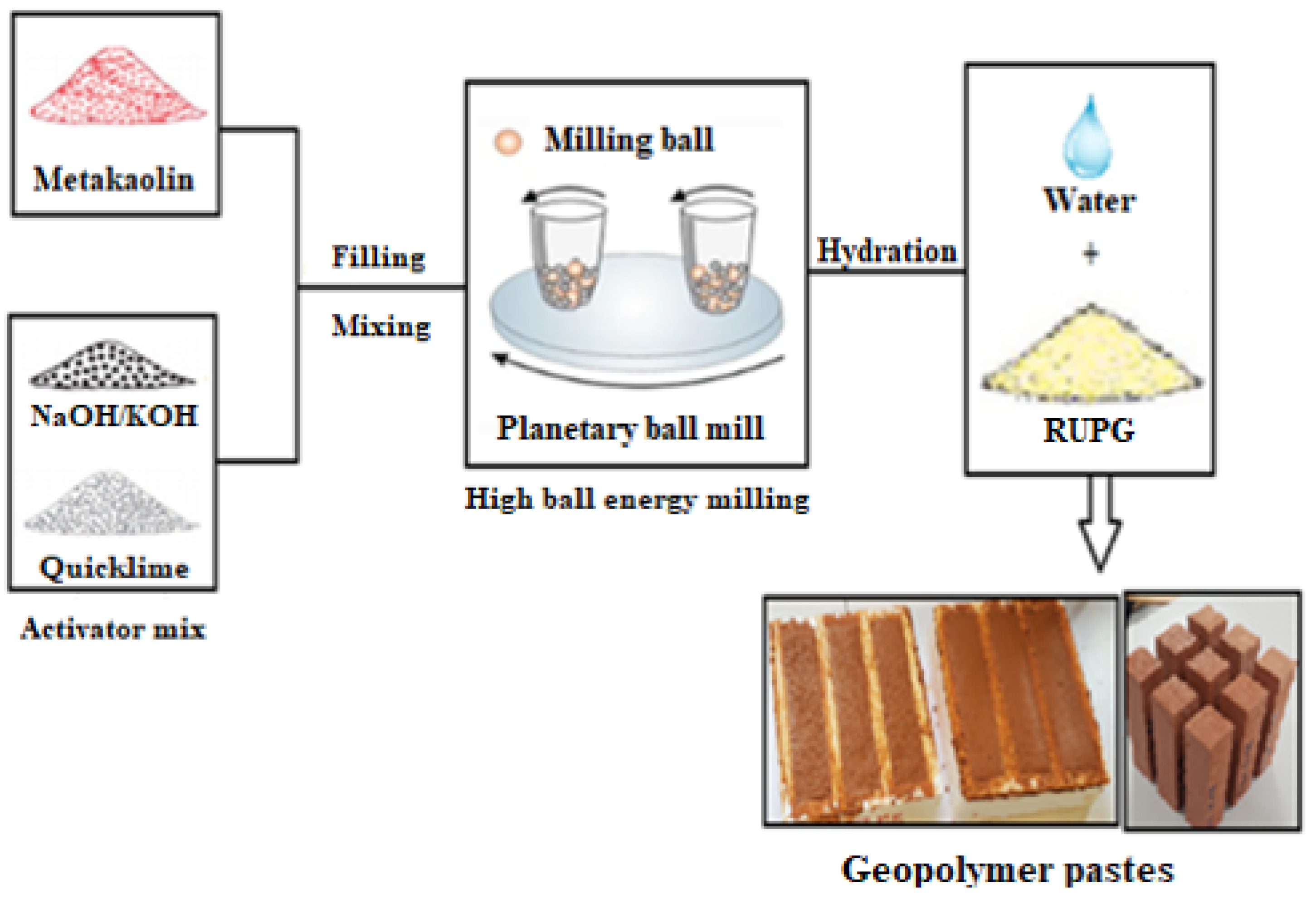

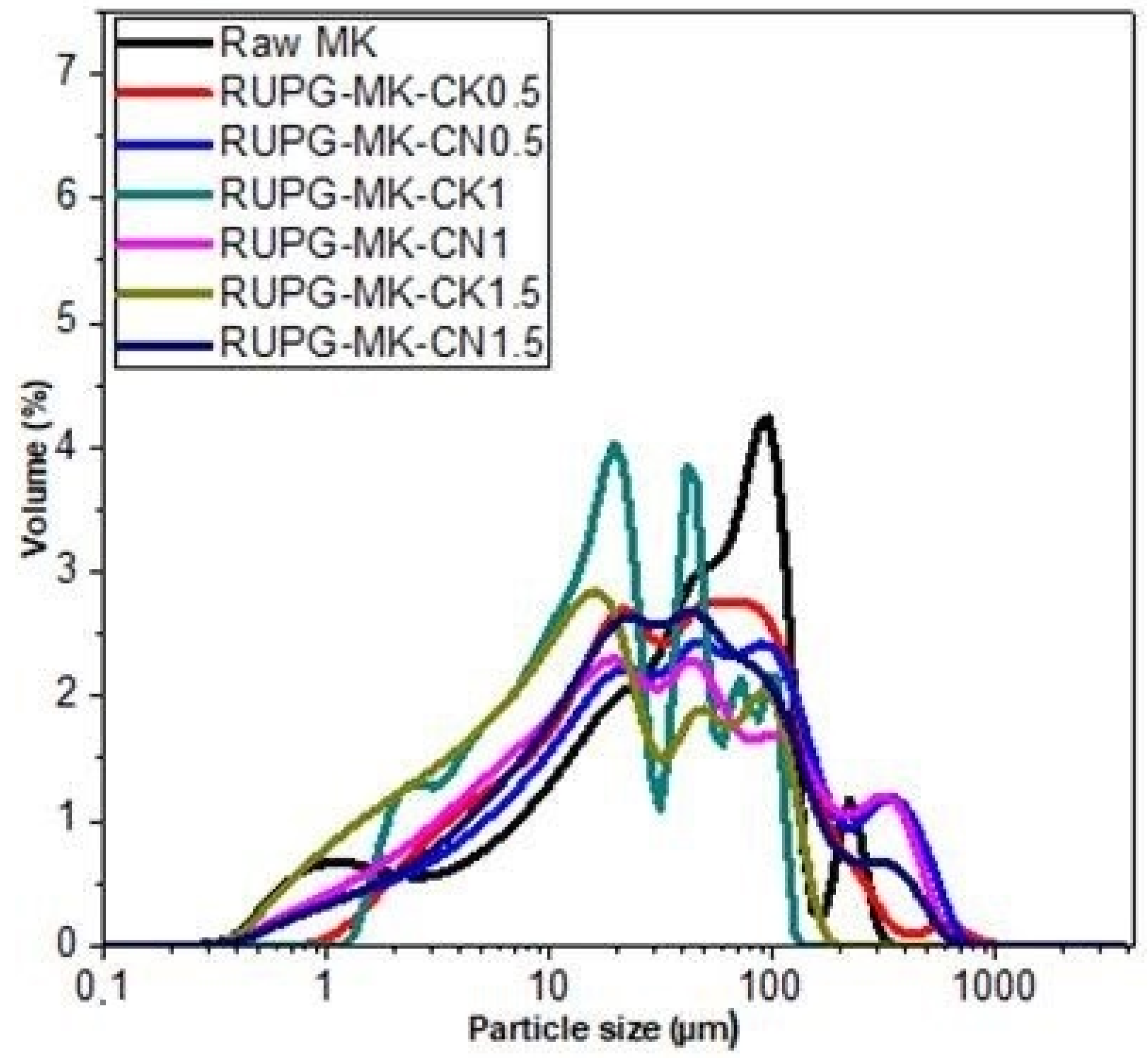
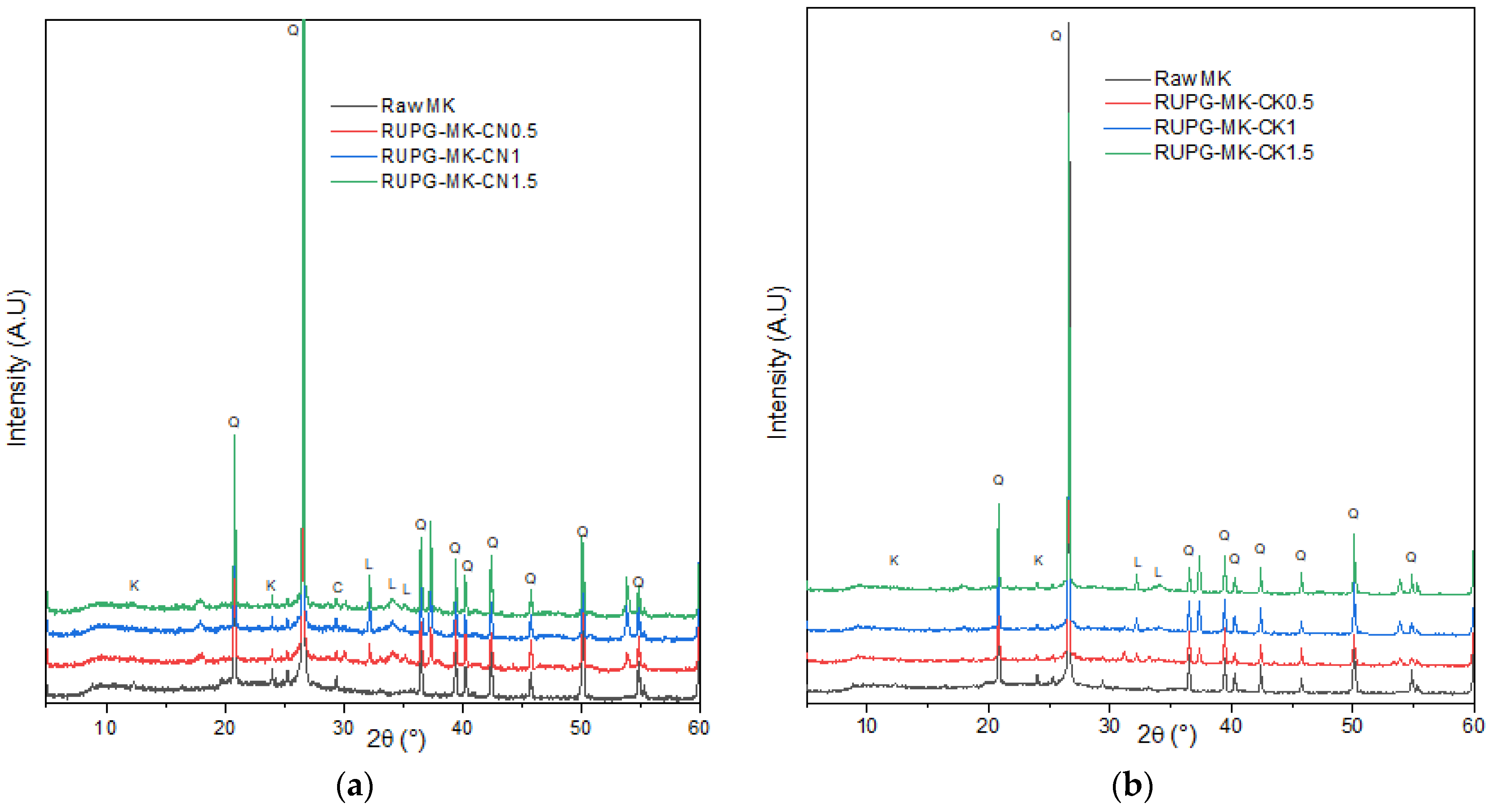

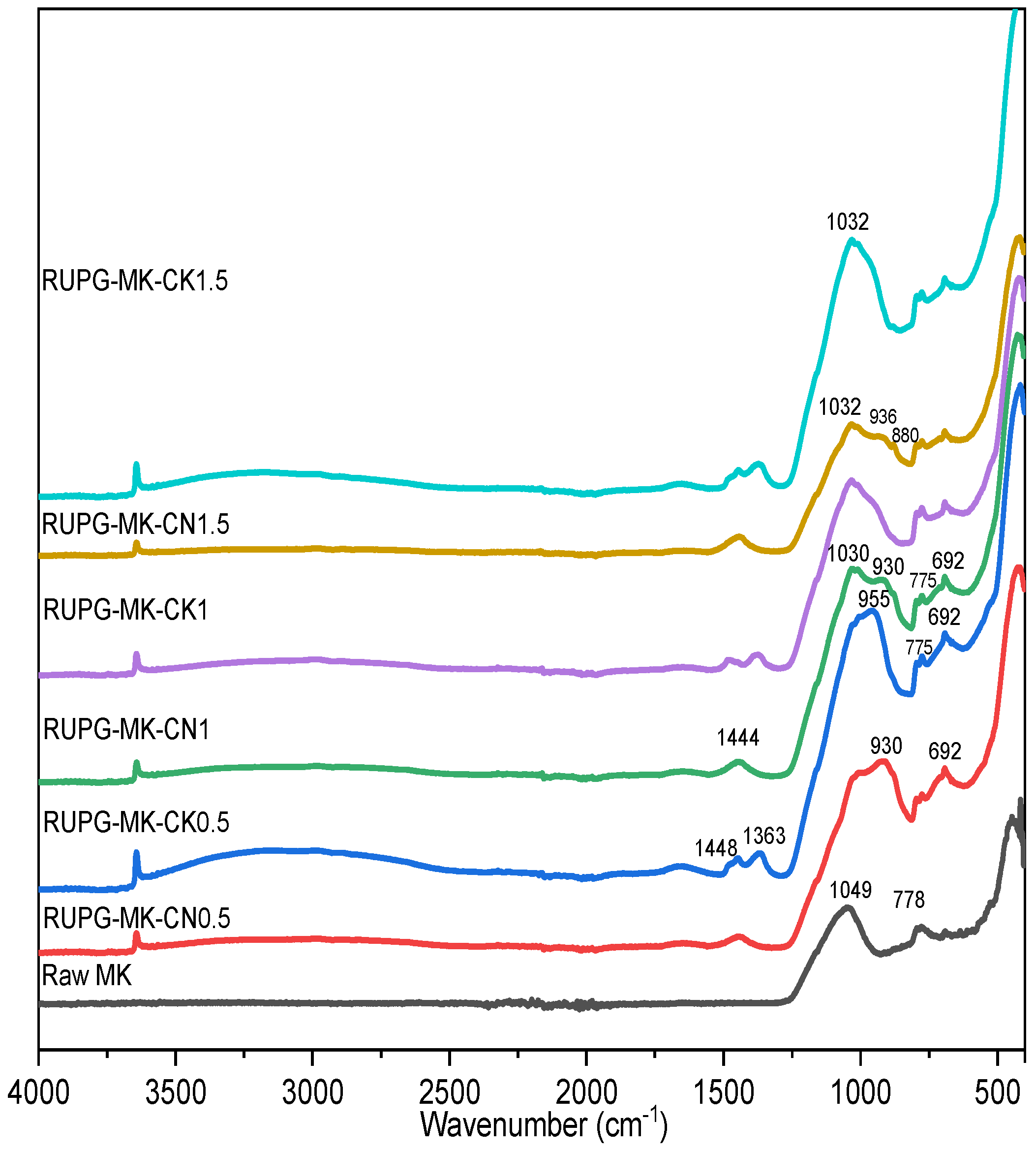
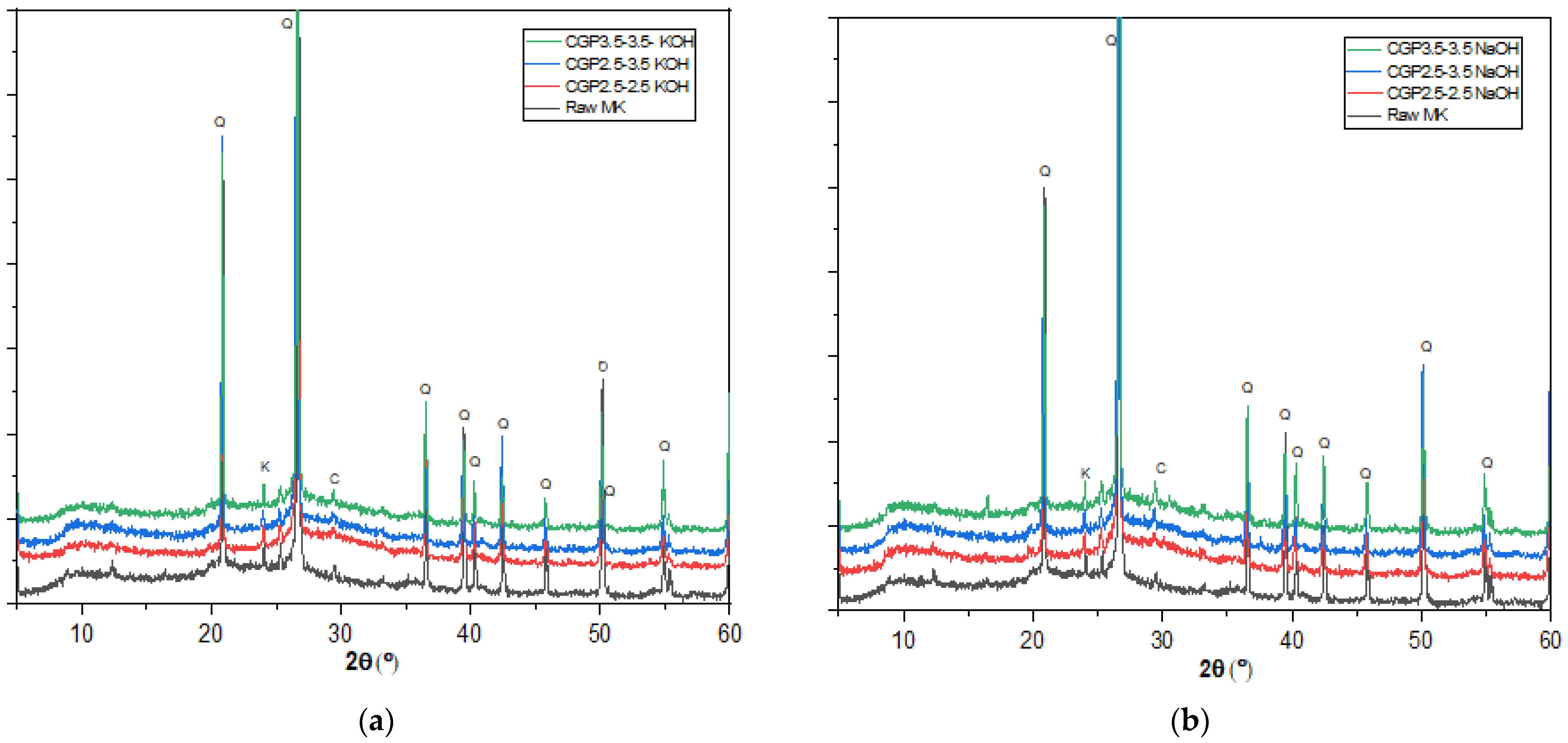
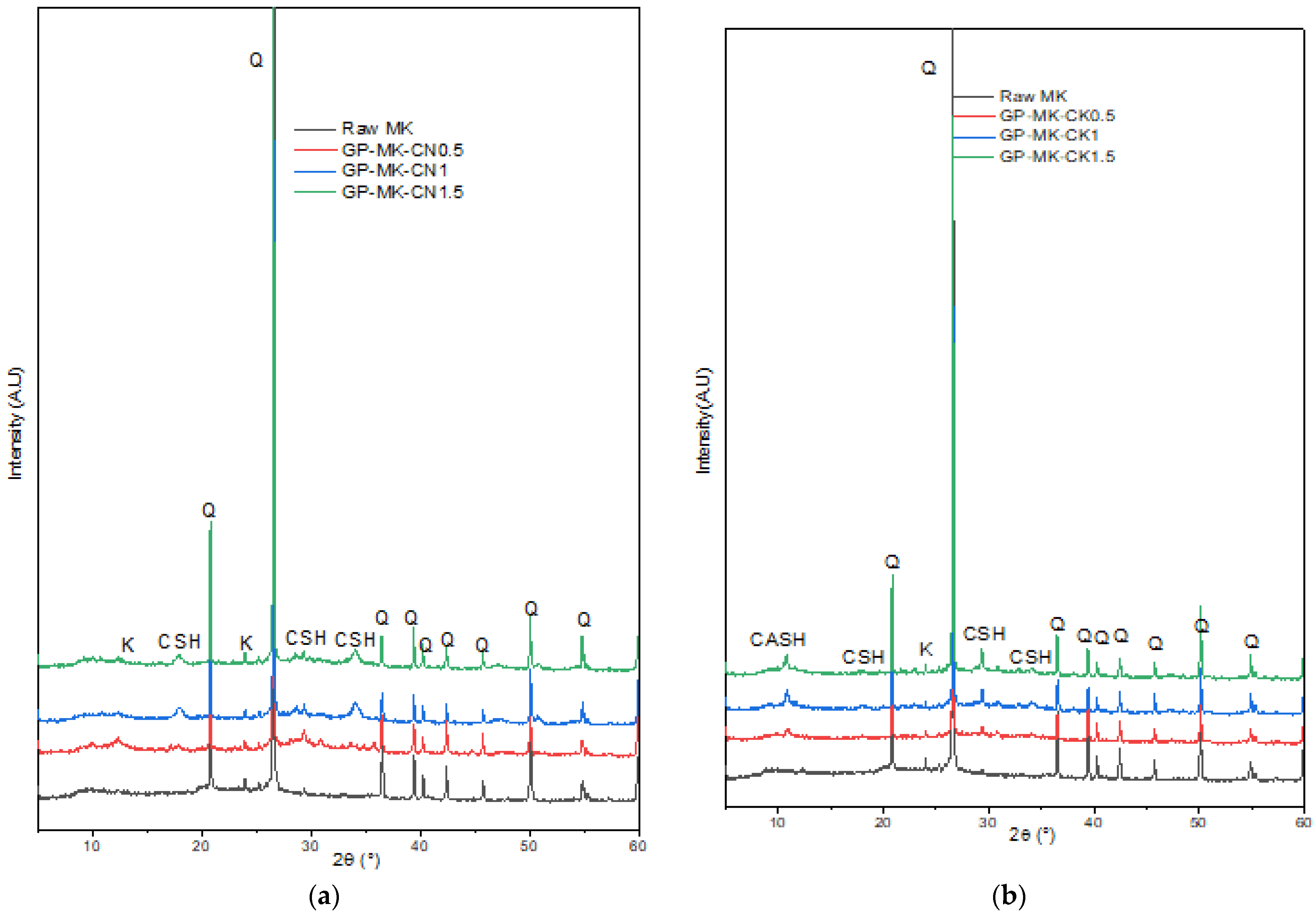
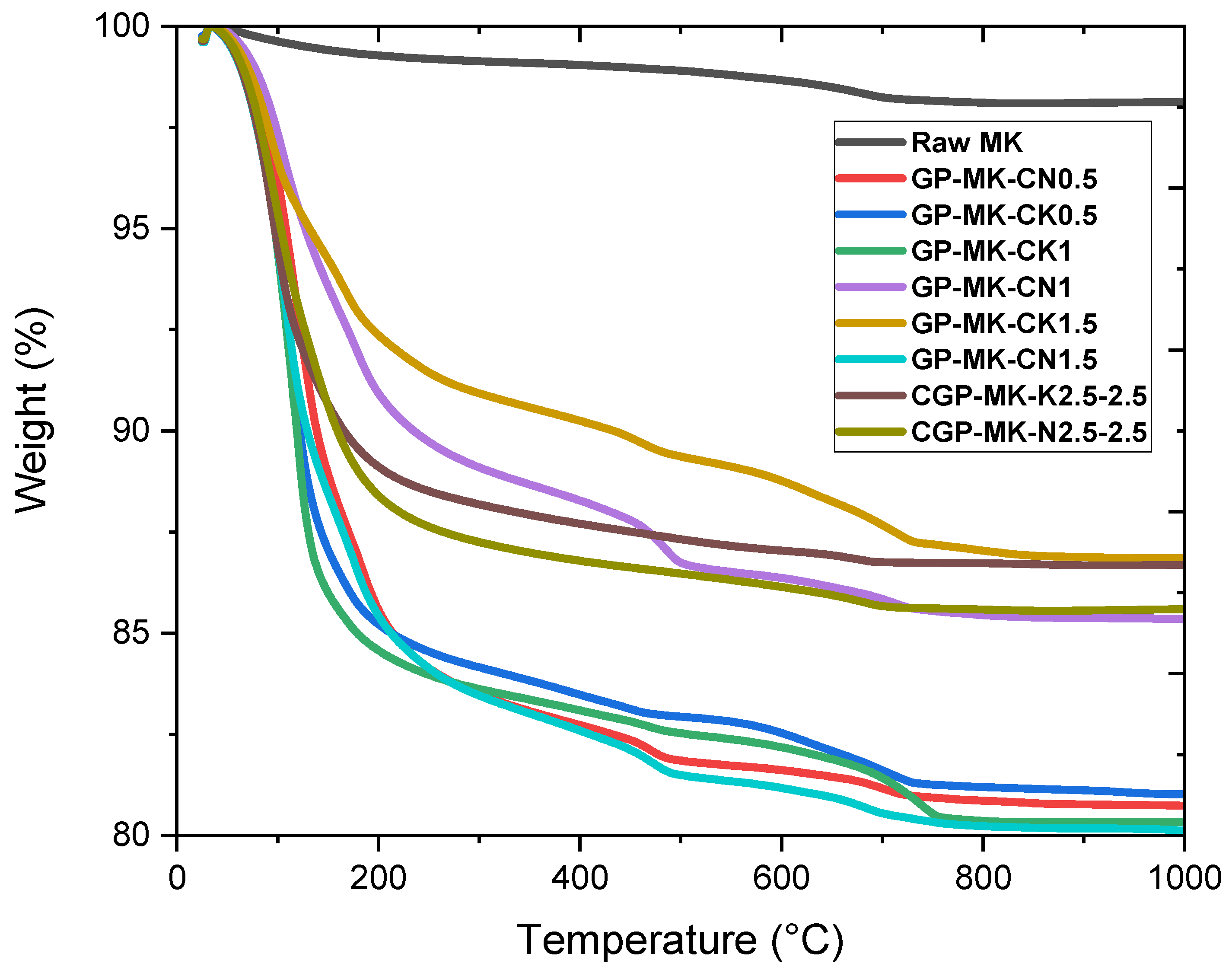


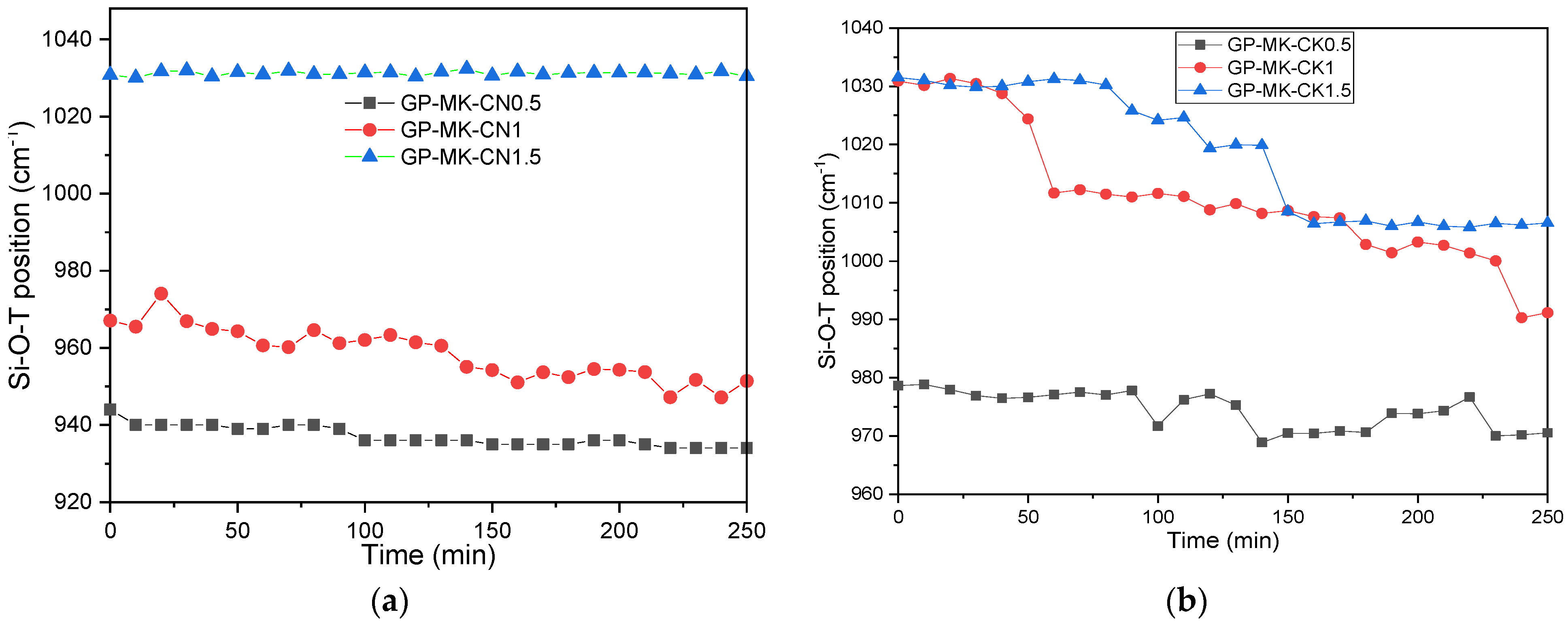
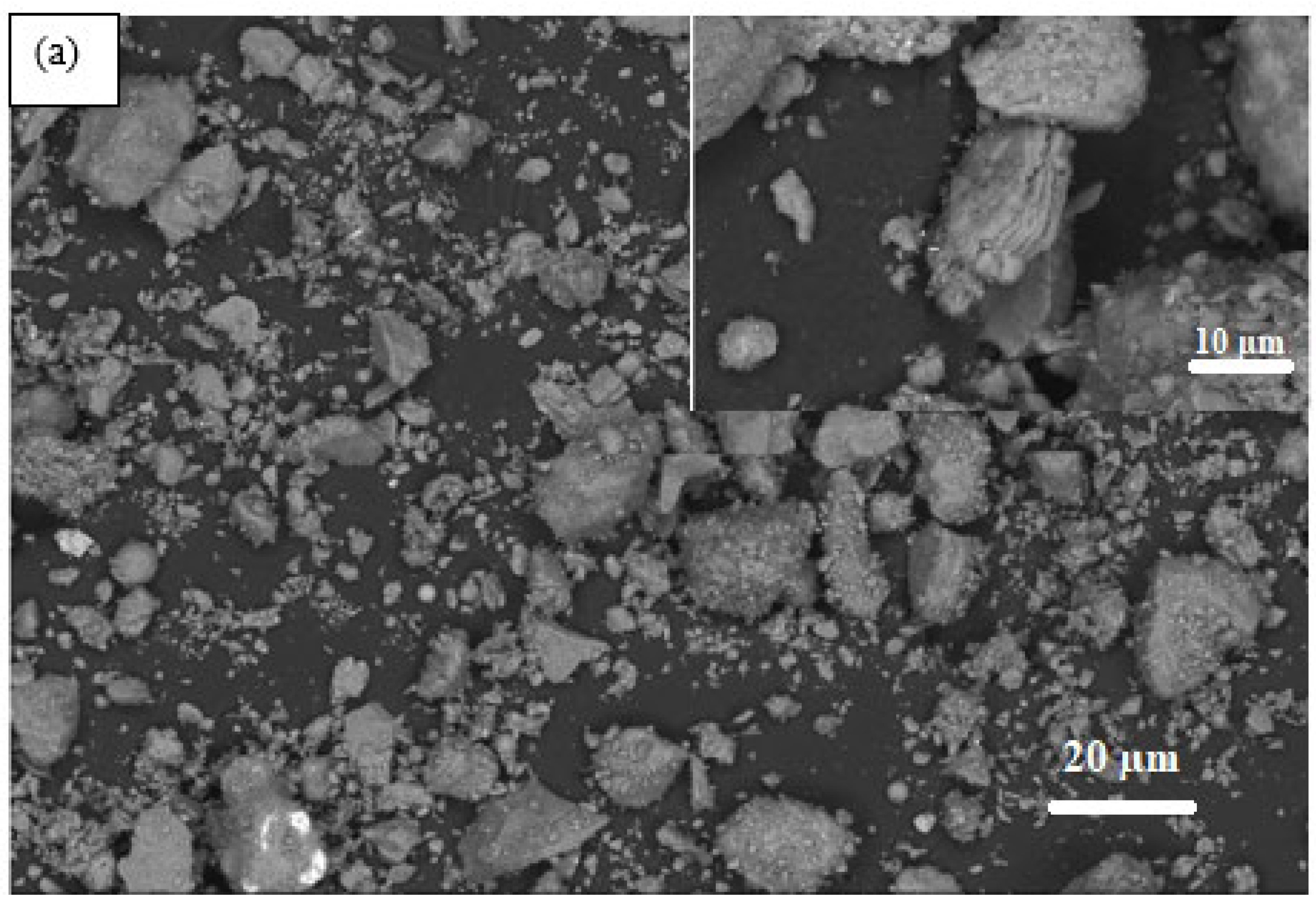
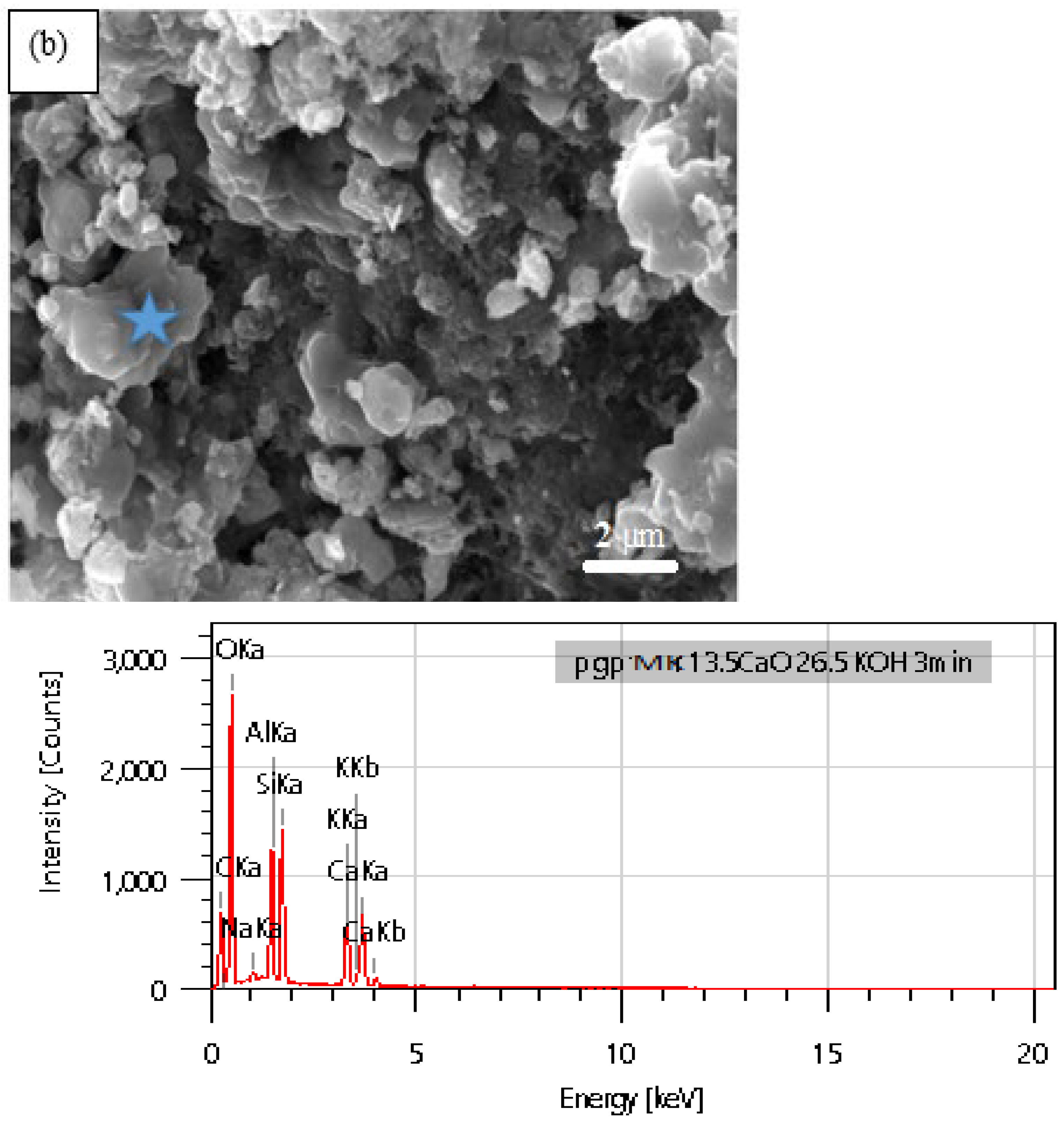
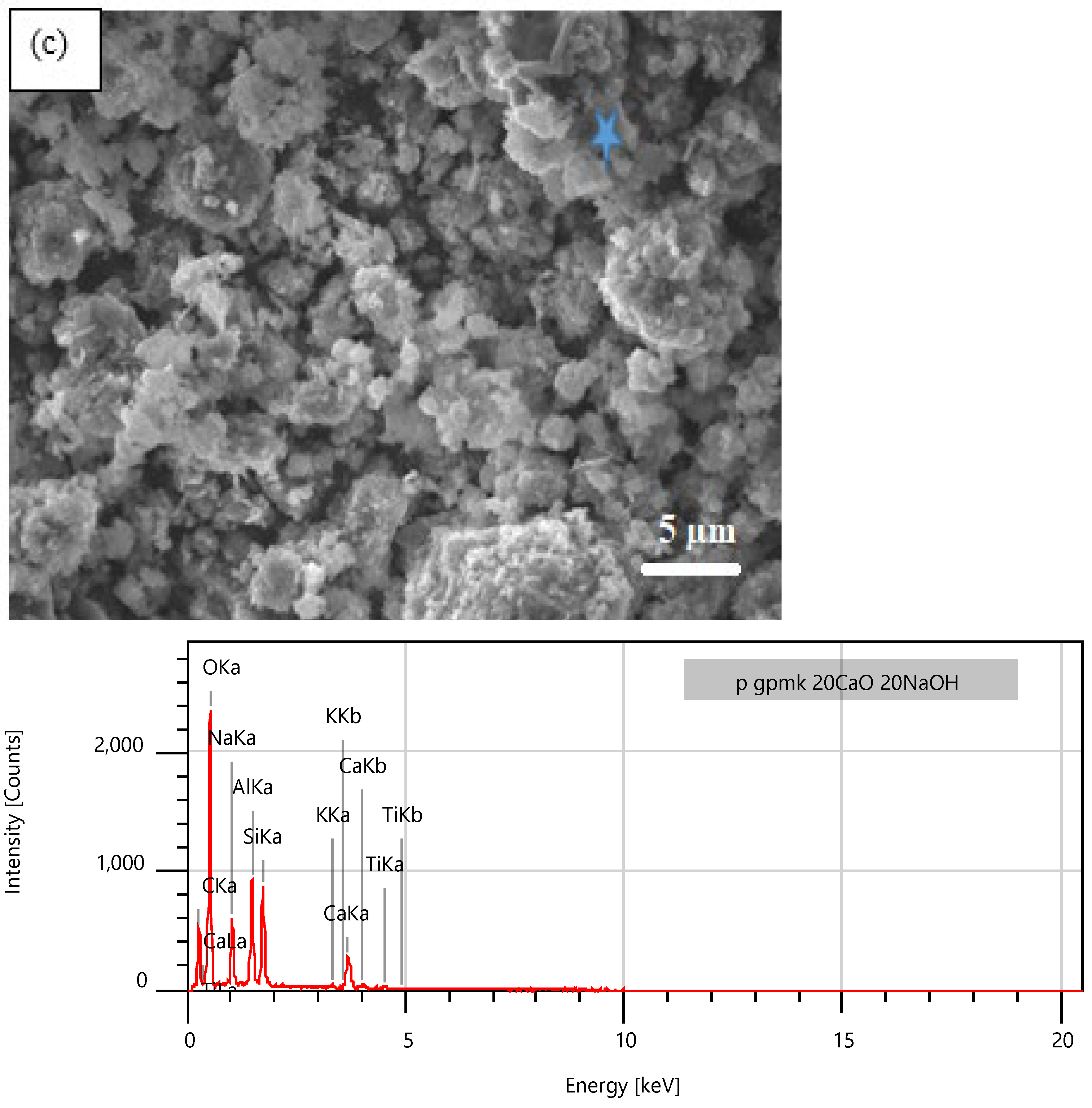


| SiO2 (%) | Al2O3 (%) | Fe2O3 (%) | CaO (%) | SO3 (%) | K2O (%) | TiO2 (%) | P2O5 (%) | SiO2/Al2O3 (%) | |
|---|---|---|---|---|---|---|---|---|---|
| MK | 62.62 | 29.03 | 3.19 | 1.44 | 0.43 | 0.50 | 1.65 | 0.64 | 2.16 |
| Sample ID | R1 | CaO/MOH | Mt (min) | Ball/Powder | Ms (rpm) |
|---|---|---|---|---|---|
| RUPG-MK-CM1.5 | 4 | 1.5 | 3 | 4 | 400 |
| RUPG-MK-CM1 | 4 | 1 | 3 | 4 | 400 |
| RUPG-MK-CM0.5 | 4 | 0.5 | 3 | 4 | 400 |
| Wavenumber (cm−1) | Attribution |
|---|---|
| 1350–1450 | C-O group vibration |
| 1049 | Si-O-T (T = Si. Al) asymmetric stretching vibration |
| 1030 | Si-O asymmetric stretching vibration |
| 930 | Si-O-Ca bond vibration |
| 778 and 692 | Si-O bond strain vibration of quartz |
| 692–702 | Si-O-Si vibration |
Disclaimer/Publisher’s Note: The statements, opinions and data contained in all publications are solely those of the individual author(s) and contributor(s) and not of MDPI and/or the editor(s). MDPI and/or the editor(s) disclaim responsibility for any injury to people or property resulting from any ideas, methods, instructions or products referred to in the content. |
© 2024 by the authors. Licensee MDPI, Basel, Switzerland. This article is an open access article distributed under the terms and conditions of the Creative Commons Attribution (CC BY) license (https://creativecommons.org/licenses/by/4.0/).
Share and Cite
Zerzouri, M.; Hamzaoui, R.; Ziyani, L.; Alehyen, S. Comparative Study of the Structural, Microstructural, and Mechanical Properties of Geopolymer Pastes Obtained from Ready-to-Use Metakaolin–Quicklime Powders and Classic Geopolymers. Materials 2024, 17, 4151. https://doi.org/10.3390/ma17164151
Zerzouri M, Hamzaoui R, Ziyani L, Alehyen S. Comparative Study of the Structural, Microstructural, and Mechanical Properties of Geopolymer Pastes Obtained from Ready-to-Use Metakaolin–Quicklime Powders and Classic Geopolymers. Materials. 2024; 17(16):4151. https://doi.org/10.3390/ma17164151
Chicago/Turabian StyleZerzouri, Maroua, Rabah Hamzaoui, Layella Ziyani, and Saliha Alehyen. 2024. "Comparative Study of the Structural, Microstructural, and Mechanical Properties of Geopolymer Pastes Obtained from Ready-to-Use Metakaolin–Quicklime Powders and Classic Geopolymers" Materials 17, no. 16: 4151. https://doi.org/10.3390/ma17164151





